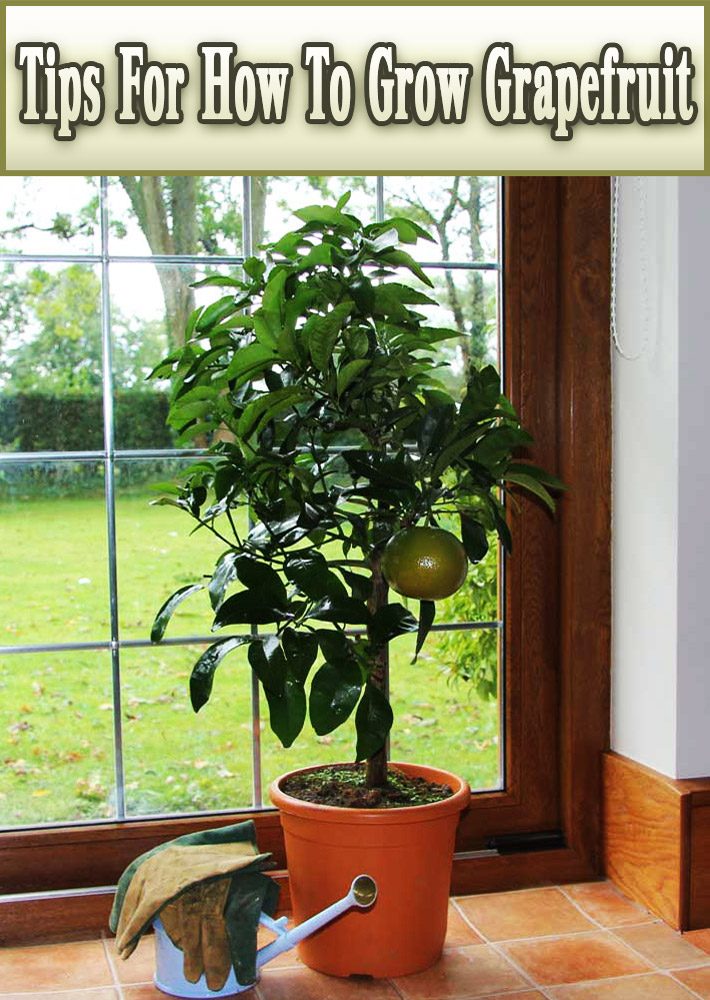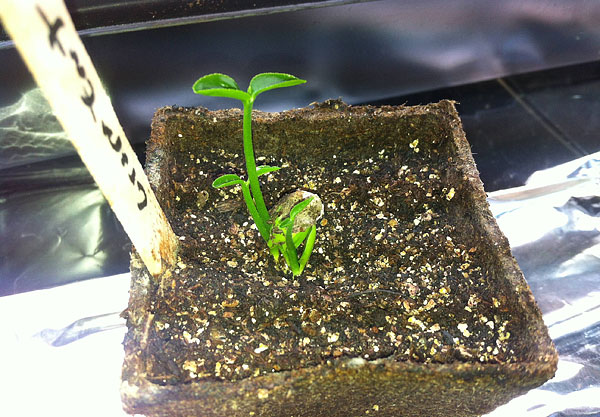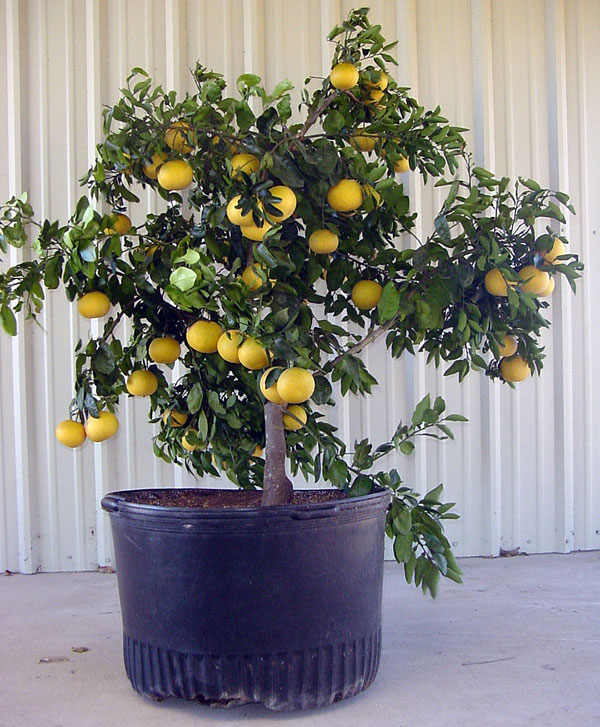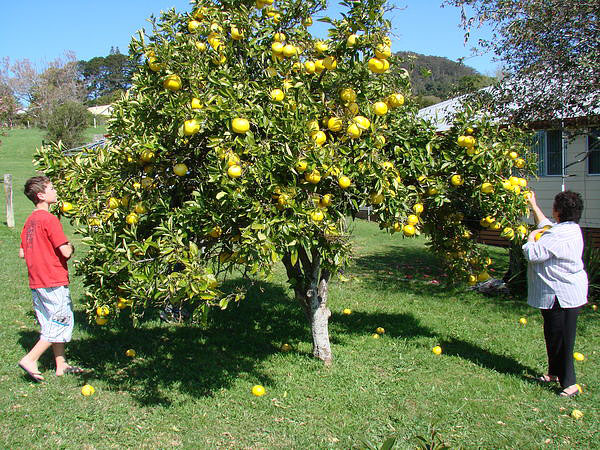
The grapefruit is actually a very modern fruit, that has only existed for a couple hundred years. It’s a hybrid of the pomelo and the sweet orange, though in some regions it is misnamed as a pomelo. Most believe that it was a natural hybrid, rather than an intentional breeding done by a gardener or fruit-grower.
The flesh inside can be pink or deeper red, depending on the variety but the outside rind is typically orange and it looks just like a large orange. Varieties known for their deep red flesh include Rio Red and Flame grapefruits.
Grapefruits tend to be sour and are usually sweetened with sugar before raw eating. Hotter climates will result in sweeter fruit. It’s a very tropical tree that will only grow successfully in zones 8 to 10.
The fruit is very high in vitamin C, and is also a great source of potassium, folic acid, fiber and vitamin A. With hardly any calories, it is very popular as a breakfast fruit, usually sprinkled with sugar. The fruit is seldom used in any cooked or baked dishes, though it is also popular juiced.
Quick Facts
- Days to germination: Seedlings are more typical
- Days to harvest: Approximately 4 years
- Light requirements: Full sun
- Water requirements: Regularly when dry
- Soil: Well-drained and fertile, with added nutrients
- Container: Not great, but dwarf varieties do exist.
Planting Grapefruit Tree
A grapefruit tree will grow to be about 15 to 20 feet tall, though older trees can be taller than 30 feet. If you are growing more than one tree, make sure to allow for 15 to 20 feet between them. Dig a hole large enough for the entire root ball to fit comfortably and cover with loose soil.
Grapefruits are self-fertile, which means the female flowers can (and will) be pollinated by the male flowers on the same tree so you don’t need to plan an orchard of several trees just to get some fruit.
When you are buying a grapefruit seedling, it will mostly likely be a grafted tree that has one kind of branching portion but a different kind of rootstock. Don’t let that discourage you, it’s perfectly normal with many kinds of citrus trees to start with grafted trees. The fruit will produce true, based on whatever kind of tree the branching portion is from.
Tree Care
Grapefruit trees should be watered at least once a week if the weather is dry, especially when the weather is very hot. You’ll also need to water your tree weekly for the first several months after planting.
In order to produce such large fruits, the grapefruit trees need a lot of nutrients so regular fertilizings are very important. A citrus fertilizer application once a month is a good idea, or at least twice per season.
These trees don’t really need any pruning, though a little maintenance each spring won’t hurt. Trim out dead branches or any that are crowded. That should be all that’s necessary.
Containers
There are some dwarf trees available, and they can usually be grown in large planters or half-barrel sized pots. They still do better when grown outside, but some cool-region growers have gotten a few fruit with indoor plants that are kept in very sunny locations.
If you do want to grow dwarf grapefruits inside, they will do better if you are able to leave them outside during the summer months and only bring them inside during the winter.
Not only are the trees smaller, but the fruit will also be noticeably smaller with container-grown dwarf trees.
Select the Right Soil Mix: Citrus need well drained soil, so selecting the right potting mix is important. Commercial potting mixes with peat moss, perlite, vermiculite and compost are fine to use as long as the soil is light enough to drain water well. If your soil is still too heavy, try adding hardwood bark chips to the mix to increase the amount of air spaces.
Potting Up the Tree: Place bare root trees in the container, gently packing in soil around the roots to remove air spaces. Plant so the citrus roots are just below the soil surface, but the crown is just above it. If transplanting an existing citrus tree into a larger container, remove the old tree and examine the roots. Cut off any dead, broken, and circling root and repot. Water well.
Fertilizing and Pruning
Fertilize in spring with a citrus plant food. Citrus need extra nitrogen, so look for formulations with double the nitrogen compared to phosphorous and potassium. If you can’t find citrus plant food in your area, timed-released or organic fruit tree foods with micronutrients are good alternatives. These slow release products will feed the plant over time. If the leaves yellow and the watering is correct, supplement the granular fertilizers with occasional foliar sprays of fish emulsion.
Prune off any new shoots that arise from below the graft union. These are rootstock shoots and won’t grow into the desired citrus variety. You can also remove thorns if you wish to make handling the tree easier. These will gradually diminish as the citrus tree ages. Prune for shape and balance in spring, removing errant or leggy branches.
Pests and Diseases
Many insect pests are common with all citrus trees, so problems with oranges or lemons can also be found with grapefruits.
Tiny aphids and scale insects are usually found on grapefruit trees, but a mature tree won’t suffer for it unless it’s a thorough infestation. A hard stream of water can easily wash off aphids, though it won’t have any effect on tough-shelled scale. If your trees have a large population of scale, there are treatment products specifically for that.
Citrus leafminers will bore through the leaves, and you will be able to see winding little patterns on each leaf. It can get bad enough that trees will start to drop their leaves, and fruit production will suffer even if the tree survives. Areas in the southern United States are prone to leafminer damage.
If you see patches of dusty black spores, your trees may have contracted sooty canker. When on the branches, you have to cut all infected material off the tree and get rid of it safely (burning is good). Once the spores have settled in the trunk, the tree is usually untreatable. It can attack the tree when there is damage to the bark, so take care when pruning and cover any cuts with an antibacterial liquid or paint (sold at nurseries) to keep out the spores.
Harvest and Storage
The exact season for grapefruit harvest can vary by region, but the fruit is usually ripe during the winter months between October and April. Young trees will only start to have fruit after the first 3 to 5 years. Depending on the variety of grapefruits being grown, you can usually judge the ripeness by the skin color. They are ready to pick once the skin is completely yellow, but a taste-test of a few fruit can help you make that decision.
Grapefruits don’t fall from the tree when they are ripe, so don’t watch for any fallen fruit as a symptom of maturity.
The trees can be prickly or thorny, so it’s usually best to wear long-sleeves during the harvest or use a long pole to gently snip or tug the fruit free.
Any fruit that is going to be used within a few days can be stored on the counter at room temperature. For longer storage, you can keep them in the lower part of your refrigerator for 1 to 2 months. They will be juicier if you let them warm to room temperature before eating though.








Leave a Reply